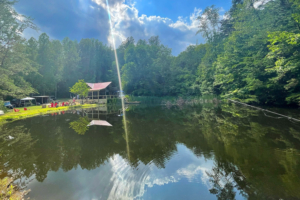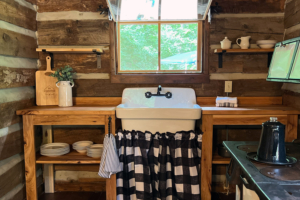Tips for Building (or Remodeling) Your Off-Grid Cabin
Building an off-grid cabin can be a rewarding — yet challenging — project, whether you’re looking to disconnect from the hustle and bustle or want to create a sought-after Airbnb in the woods.
Off-grid living allows you to be self-sufficient and disconnected from the power grid, and truly off-grid homes don’t rely on outside sources for electricity (or water). While some might find the idea of unplugging frightening, an off-grid log cabin can make a fantastic getaway or even a long-term homestead. Want to learn more? Let’s get to work!
Table of Contents
- Benefits of Off-Grid Living
- Lakeside Off-Grid Cabin Gets an Upgrade
- Off-Grid Cabin Building Challenges
- How to Build an Off-Grid Cabin
- Find a Piece of Land for Your Cabin In the Woods
- Plan Your Cabin Building Budget
- Source Appropriate Building Materials
- Plan Your Power Source and Running Water
- Determine a Off-Grid Power Source
- Solar Panels
- Propane Generator
- Wind Turbines
- Hydropower
- Source Running Water for Your Property
- Install Plumbing for Your Off-Grid Living
- Invest in the Best Off-Grid Cabin Materials
Benefits of Off-Grid Living
There are a lot of perks that come along with having an off-grid cabin. For one thing, a beautifully built log cabin has a unique charm that can’t be beat. On top of that, a tiny home or log cabin can be a great choice for both you and the environment:
- Reduce reliance on fossil fuels
- Reduce greenhouse gas emissions
- Build practical DIY skills
- Improve your mental health
- Save money
Off-grid living boosts your own piece of mind while improving the environment. With the rising cost of electricity and other public services, it can also be a sustainable way to save money.

Lakeside Off-Grid Cabin Gets an Upgrade
Baird Brothers Fine Hardwoods teamed up with Outdoor Channel’s Renovation Hunters to give an off-grid cabin in Critz, Virginia a much-needed upgrade. Even though the cabin had minimal square feet, together, the partners provided a huge remodel for the family.
In a recent episode of American Hardwood Advisor, host Steve Stack revisited the log cabin in the woods a year later to see how the family adapted since the show’s visit. Watch the full video to hear from homeowner Todd Joyce and his parents on how Renovation Hunters changed their small cabin for the better.
Watch Here:
Off-Grid Cabin Building Challenges
Off-grid living can come with its own unique challenges. While it can save you money in the long run, if you aren’t sure how to power your small cabin properly, then you may make costly mistakes.
People looking into off-grid cabin building and remodeling often face a few common challenges:
- Finding the right power source
- Sourcing clean water
- Solving plumbing problems
- Finding the right location
- Locating appropriate building materials
Depending on how isolated and how off-grid your log cabin or tiny house will be, you may also need to make sure you have a reliable source of food (or way to store food) – afterall, if you’re building in the Canadian wilderness, Walmart won’t be right around the corner and Amazon deliveries will be few and far between.
How to Build an Off-Grid Cabin
The challenges that come along with off-grid cabin building can be overcome with the right planning and DIY skills. Good log cabin building begins with a good plan. While you may be tempted to dive straight into planning the decor, there are a few steps you need to take to ensure your small cabin is a big success.

Find a Piece of Land for Your Cabin In the Woods
First things first – choose where you’ll be building! If you’re building a retreat in the tundra of Alaska, you’re going to need a very different budget than if you were building a tiny home in the woods just outside of your city limits.
There are important factors for picking a location:
-
- Cost of transporting materials
- The types of building materials you’ll want to use
- The cost of the land
- The building-code requirements you’ll need to follow
- The kind of power source(s) you’ll want to use
Popular states to build an off-grid cabin include California, Colorado, Alabama, Oregon and Mississippi. Look for an area that has plentiful natural resources, and, if you plan on using solar power, a place that gets a lot of sun.
Plan Your Cabin Building Budget
Once you have the location, it’s time to start budgeting. For a well-planned budget, make sure to consider what DIY skills you have, what resources the land has, and what tools and materials you’ll be using.
Here’s a good list of starter questions to initiate your log cabin budget planning:
-
- Will you be buying your lumber new, using recycled lumber, or sourcing your lumber from your own land?
- What tools will you need to build your off-grid cabin?
- For example, if you plan on using your own timber, you will need a saw mill. If you have to haul heavy materials, you may need a tractor.
- Do any of your power tools require a constant power source, and how will you supply it?
- How will you be transporting materials to the cabin building site?
- How many public utilities are you disconnecting from?
- What are the most cost-efficient utility replacements for your chosen piece of land?
- How many people will be able to stay onsite? (Do your research on power sources/water sources so that you know they are sufficient for your needs.)
- Have you determined a floor plan and assessed the needs in each space?
- For existing cabins, do your due diligence and make sure items like the wood stove are in good working condition. For new builds, make a list of immediate needs and wants (and a second list of items that you’d like to have but can wait on until funds are available).

Source Appropriate Building Materials
If being a part of nature is so important to you that you’ve decided to build or remodel your own off-grid cabin, then staying away from big box stores is likely a priority, too – not to mention the fact that many of those stores don’t carry the type of products that are best suited for rustic cabins (like red oak S4S lumber, knotty ponderosa pine products, butcher block countertops, etc).
Even though shopping at big box stores can provide a level of convenience, they are also known to generate a great deal of greenhouse gas emissions due to their extensive transportation of goods (often starting overseas, then going to distribution centers before reaching the individual store, and then eventually making it to the end user).
In comparison, by utilizing a company like Baird Brothers Fine Hardwoods, you’ll be sourcing products from a company that has been focused on sustainability and minimizing its footprint for decades. From working with timber companies that implement and practice sustainable forestry processes to repurposing cut-offs and using sawdust to power our entire facility, Baird Brothers is always working to be a steward of our natural resources.
Plan Your Power Source and Running Water
Figuring out how to be self-sufficient is often the most complicated part of off-grid living. Depending on how off-the-grid you want your property to be, you may have to replace not only your source of electricity, but also your running water and plumbing (and even food supply).
But, the good news is that you don’t have to be a master of bushcraft or give up indoor plumbing to enjoy off-grid living. You do, however, have to be good at planning. Why? Because making a mistake about what kind of power supply you want to use can be inconvenient and costly if you decide to change your mind later.
Determine a Off-Grid Power Source
Here are some of the most common ways you can supply electricity:
Solar Panels
One of the most common off-grid power sources is solar energy. You can DIY install solar panels or hire professionals for a relatively low cost.
Propane Generator
A propane-run generator may be a good choice for your off-grid cabin, especially if you build your tiny home in an area that doesn’t get much sun.
Wind Turbines
Wind power doesn’t require massive windmills to generate electricity. You can use wind turbines alone or in combination with solar panels to supply your off-grid cabin with power. Make sure when installing wind turbines that you follow any regulations in the area you are building in.
Hydropower
If you have a small stream with a strong enough current, you can use the flow of the water to generate electricity. Place a turbine in a good stream and it can be more reliable than the wind and the sun.
Source Running Water for Your Property
Clean and reliable water is an essential part of life. When it comes to supplying it to your off-grid log cabin, there are a few options you can consider.
-
- Well water and lake water: If your off-grid cabin has a well, or if it doesn’t and there’s a lake nearby, you can connect them to a piping system and have water pumped into your property, whether it’s a tiny cabin or a four-bedroom property. If you are going to use lake water, be sure to check and see if you need a permit to hook up the system first.
-
- Rain water: You can install a water storage tank to collect rain and pump running water into your log cabin.
Install Plumbing for Your Off-Grid Living
No homestead is complete without a way to eliminate waste in a private and sanitary way.
If you have a reliable off-grid power source, you can purchase a septic system and install a regular, modern toilet. If a septic system seems too costly, or the installation beyond your DIY skills, you can also consider these alternatives for your off-grid cabin.
-
- Outhouse
- Composting toilet
Invest in the Best Off-Grid Cabin Materials
With a smart, off-grid cabin budget, people have managed to build self-sufficient, tiny homes for as little as a few thousand dollars. With the savings that comes with off-grid living, this means you can often easily make back the money you invest in off-grid cabin building.
If you want your off-grid cabin to be a long-term homestead, or even if you plan on using your new log cabin as a rental, remember that you want to use building materials that can stand the test of time (along with the elements).
When it comes to hardwood lumber, make sure you’re using the best for your property. Baird Brothers Fine Hardwoods is your trusted resource for long-lasting, high-quality hardwoods – perfect for your off-grid cabin or any other DIY project you have on deck. Reach out today or visit our store to start making your dreams a reality.



